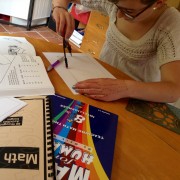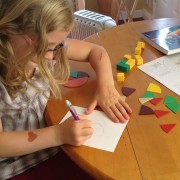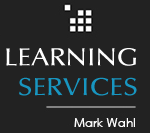Math Educators or parents, I’m Mark Wahl…

Owner/director of Mark Wahl Learning Services and Books.
Below: How to “colorize” and “energize” any math teaching style!
[For teacher professional development Click Here]
Searching for these books ? (Click the “Books to Buy” link at the top).
 Math for Humans: Teaching Math Through 8 Intelligences
Math for Humans: Teaching Math Through 8 Intelligences
A Mathematical Mystery Tour
Math Nuggets: 80 Thoughtful One-Page Activities for Insight and Pleasure.
Are you a parent trying to improve your child’s math learning experience?
Wish to better understand your child’s individual math needs and communicate to teachers about them? Read on.
Do you homeschool your child in math? (Click the “Homeschooling” link at the top.)
Enjoy some motivational ideas: Mark’s videos on fraction concepts (~5th gr), integers (~7th gr).
Pi Search: Go to http://angio.net/pi/ Search Pi’s digits 3.1415926535… for your phone number (without area code )! For example: Seven phone digits 2345678 (these start in this order at position 995,998 in the digits of Pi! Find any favorite 4-7 digit number present in Pi’s first 200,000,000!
Using resources shown on this site you can:
- Penetrate math using your own multiple intelligences,
- Enjoy unique math activities while exploring with your students,
- Find unique professional development possibilities (see that link at the top)
- Excite and motivate bored or fearful learners,
- Savor the mysteries and aesthetic marvels of number,
- Let other subject areas colorize your math lessons, and
- Expand your teaching comfort zone
- Find fascinating links to other math sites.
Here’s an informative review of two of my books, Math for Humans and the Mathematical Mystery Tour (with it’s earlier cover). These will offer you ways to pursue the approaches suggested below:
You’ve probably discovered that successful math learning (useful, conceptually grounded, transferable to new situations, real-world relevant) is pretty rare — to be treasured when it happens. But how to make that happen more often — that’s the question.
Math learning is an obstacle-course for most.
Obstacles to quality math learning are plentiful. In my many years of experience I’ve probably seen them all, including:
- family disaster stories about math’s difficulty,
- terror-producing teaching methods,
- fuzzy or meaningless explanations,
- lack of any link between math and real life,
- a rush into formal abstract math without any concrete physical or pictured experience,
- a robotic, imitative, memorized style with little conceptual grounding,
- a habitual disconnect between a child’s natural style and a superimposed alien math style.
 How students leap to math success
How students leap to math success
Youths can leap over any of these obstacles to math success. I’ve seen it more times than I can count! Having been in the business of waking kids up to math for thirty years, I know that the right approach can make up for a multitude of assumed impossibilities and disabilities–poor self-image, hating math, “spacing out,” constant forgetting, blowing tests even with a high homework grade, some ADD, some ADHD, “dyscalculea,” etc., etc.
Classes, groups and individuals, exposed to my different approaches experience dramatic results. Dynamic professional development seminars and my three books help teachers stimulate students’ natural learning abilities, bringing kids out of the math doldrums into math power. (Click the “Professional Development” and/or “Books to Buy” tabs above if you want to look at them.)
Young people, or even adults, just need to get the real scoop behind the methods in a clear and fun way. They are thirsty for the concepts, the number sense, the “gut feeling,” the internal knowing that what they are doing is right. Yes, even if they just say “I’m bored,” or “This sucks!” they would love to be truly turned on to math. They just don’t think it’s possible. Let’s face it, math boredom, anxiety, and hatred are legitimate, —even healthy— reactions to material that is meaningless, monotone, black-and-white and repetitive. How would you react with a daily portion of sawdust for your meals
 How students regain contact with their “gut feeling” in getting answers
How students regain contact with their “gut feeling” in getting answers
Here’s a simple, basic example touching on the bodily-kinesthetic and visual-spatial intelligences of a child (there are numerous others that could show you more in-depth use of these and other intelligences). How much is 30 ÷ 1/2 + 10? Answer fairly quickly!
“Twenty-five,” say even some teachers if asked to answer quickly, and so do most kids. This comes from a misunderstanding of the nature of all division questions. Even if you get it right by doing the little flip trick you learned in school, does the answer you got really make sense to you?
Let’s bring in a little bodily, physical, “gut” sense to this abstract question. What does 20 ÷ 5 mean? Not what’s the answer, but what does it mean? It means one of two things: “How many 5s can be packed into 20?” (the packing question), or “If 20 is cut into 5 same-sized parts, how much is in each part?” (the cutting question).
Let’s consider 30 ÷ 1/2 as a packing question. It’s asking how many 1/2 units (or dollars) will pack into 30 units (or dollars). The answer is of course, 60 and no one could persuade you otherwise. Then add 10 to get the correct answer to the question: 70. And you have it with conviction.
Our math friend the Bodily-Kinesthetic Intelligence
The above discussion is a very simple example of switching the intelligence “channel” for input of information. In this case it was switched from the usual linguistic/symbolic and logical/mathematical channels often used (poorly) to communicate math with nod to the bodily-kinesthetic channel where the physical notions of packing and cutting were employed (either verbally or, better, with dramatic body motions in both teacher and learner) for “gut” understanding.
You can do it with the Visual/Spatial Intelligence too
You can also switch to the visual/spatial/diagrammatic channel and leap to clarity in division. Just draw 30 circles and cut each in half with a line
Gardner’s multiple intelligence theory is a breakthrough for math teaching.
There are eight intelligences highlighted by researcher Howard Gardner. Each has been painstakingly proved by him to be equivalent to any other by any scientific criterion you can think of. When we speak of someone being “intelligent,” instead of meaning they are verbally sharp or they are powerfully logical, we can actually accurately mean they are intelligent in any of six other ways: interpersonally, kinesthetically, spatially, intrapersonally, musically or naturalistically. If that’s so, it stands to reason that if you teach math through all the intelligence channels you have a vastly increased chance of reaching every brain you are working with.
Now, a Manual on how to teach or explain math through eight intelligence channels!
I’ve gone into this and many other teaching strategies in great detail in my book just reprinted in June 2013 with key revisions and updates: Math for Humans: Teaching Math through 8 Intelligences geared primarily for grades 3-9. As author, I’m offering this 256-page book, with extensively illustrated 8 1/2 × 11 pages, chock full of teaching ideas and many ready-to-go activities to you for $34.95 (web discounted) and signed (a real bargain for an author-signed book)! Thousands of teachers and parents have already gladly paid this for the wealth of ideas they gained. Don’t delay, get this help for your teaching now! Click here to view the book and some other choices. Math for Humans: Teaching Math Through 8 Intelligences. And check out my classic A Mathematical Mystery Tour now just $27.95 and signed — a book that can give your students goosebumps and metaphysical insights as they learn math skills using the naturalist, visual-spatial and interpersonal intelligences among others! The free accompanying Mystery Tour Guide adds depth, practice, and entertainment to the book. The fascinating Millennium Supplement is meant to accompany this book (extra $7.95 cost) and raise its challenge to high school algebra level while also updating and adding to content of the Mystery Tour for 5th grade and up. For all Click Here . A Mathematical Mystery Tour.
Contact Mark directly at 360-221-8842 or mathman@markwahl.com
